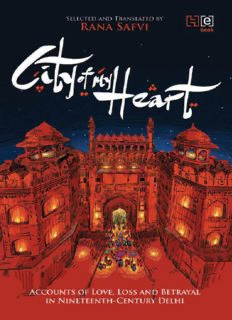
City of My Heart: Four Accounts of Love, Loss and Betrayal in Nineteenth-Century Delhi PDF
Preview City of My Heart: Four Accounts of Love, Loss and Betrayal in Nineteenth-Century Delhi
ACCOUNTS OF LOVE, LOSS AND BETRAYAL IN NINETEENTH-CENTURY DELHI TRANSLATED BY RANA SAFVI First published in 2018 by Hachette India (Registered name: Hachette Book Publishing India Pvt. Ltd) An Hachette UK company www.hachetteindia.com This ebook published in 2018 Translation copyright © 2018 Rana Safvi P. 245 constitutes an extension of this copyright page. Rana Safvi asserts the moral right to be identified as the selector and translator of this work Every effort has been made to trace copyright holders. Any omissions brought to our attention in writing will be remedied in future editions. All rights reserved. No part of the publication may be reproduced, stored in a retrieval system (including but not limited to computers, disks, external drives, electronic or digital devices, e-readers, websites), or transmitted in any form or by any means (including but not limited to cyclostyling, photocopying, docutech or other reprographic reproductions, mechanical, recording, electronic, digital versions) without the prior written permission of the publisher, nor be otherwise circulated in any form of binding or cover other than that in which it is published and without a similar condition being imposed on the subsequent purchaser. The map on p. xxix is an illustrated representation and has not been drawn to scale. The views and opinions expressed in this book are those of the respective authors’ and the translator and the facts are as reported by them. The publishers are not inany way liable for the same. Hardback edition ISBN 978-93-5195-258-9 Ebook edition ISBN 978-93-5195-259-6 Cover illustration by Shiraz Husain Usmani Cover design by Pia Alize Hazarika Hachette Book Publishing India Pvt. Ltd 4th & 5th Floors, Corporate Centre, Plot No. 94, Sector 44, Gurugram 122003, India Typeset in Arno Pro 11/14.8 by Manmohan Kumar, New Delhi For Dilli and Dilliwaalas, who accepted me as their own Jahanabad never deserved this tyranny As it was once the heart of lovers, many It has been erased like a wrong letter by destiny It was one such shore in the ocean of the world From whose dust people used to pick pearls. – Shahr Ashob (Lament for a City) MIRZA MUHAMMAD RAFI SAUDA Contents Foreword Translator’s Note Preface Dilli ka Aakhiri Deedar The Last Glimpse of Delhi Syed Wazir Hasan Dehlvi Bazm-e-Aakhir The Last Assembly Munshi Faizuddin Qila-e-Mu’alla ki Jhalkiya’n Glimpses of the Exalted Fort Mirza Ahmad Salim ‘Arsh’ Taimuri Begamat ke Aansu Tears of the Begums Khwaja Hasan Nizami Appendix Copyright Acknowledgements Acknowledgements Foreword The Urdu texts ably translated here by Rana Safvi are key documents to understanding the social and cultural life, and the political imperatives of the Exalted Fort during the first half of the nineteenth century. It is a period much maligned by comprador historians as effete and decadent. In reality, it was a time rich in cultural and intellectual activity, marked by social and communal harmony, and life inside the Fort was the paradigm of it all. This translation performs a much needed service and corrects the perspective by which the first half of the nineteenth century has so far been viewed. This is a valuable contribution to India’s cultural history. Shamsur Rahman Faruqi Translator’s Note When Mirza Abu Zafar Sirajuddin Muhammad Bahadur Shah or Bahadur Shah II, better known by his pen name Bahadur Shah Zafar, ascended the Mughal throne in 1837, he inherited an empire that was only nominally his. The writ of the British ran through the territory of Mughal India, or whatever was left of it; Zafar was their pensioner. The British Resident was in charge, both in Delhi and in the ‘Qila’, the Red Fort. Along with the empire, such as it was, Zafar had also inherited the secular outlook of his ancestor Akbar and his own father, Akbar Shah II. He believed that his subjects were his children, and on the night of 16 September 1857, as he was leaving the Qila after the fall of Delhi, his last prayer, as recorded by his daughter and eyewitness Kulsum Zamani, was, ‘The entire Hindu and Muslim population of Hindustan are my children and trouble surrounds them all. Don’t let them suffer because of my actions. Give them relief from all troubles.’1 There was occasional friction between Hindus and Muslims, but never any large-scale violence or deep mutual distrust. Indian society in the nineteenth century lived largely in communal harmony. Both Hindus and Muslims were devoted to the Emperor and would participate in the jharoka darshan2 every dawn, when Zafar appeared in the balcony of the Musamman Burj in the Red Fort. Akbar Shah II, who started the Sair-e-Gul Faroshan or Phoolwaalo’n ki Sair, the procession of the flower-sellers, would offer pankhas3 both at Qutub Saheb’s dargah and at the Jogmaya temple in Mehrauli. Zafar surpassed his father; he would not go to the dargah if he couldn’t visit the temple the previous day. When Zafar was exiled to Rangoon (now Yangon) after the fall of Delhi, there was a palpable sense of loss amongst Hindus and Muslims alike, who felt as if they had lost their father. Once the British prevailed upon ‘rebel sepoys’ and captured Delhi in September 1857 after a siege of four months, they arrested the Emperor and imprisoned him. In a travesty of a trial, Zafar was tried and found guilty on four counts – aiding the mutinies of the troops, encouraging people in
